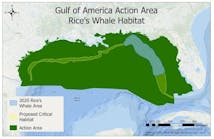Rodney Jackson
Louisiana Department of Natural Resources
Baton Rouge
Cumulative production from Chandeleur Sound off Louisiana and the area immediately to the south exceeds 34,116,065 bbl of oil and condensate and 280,996,188 Mcf of gas since 1948.
Most of the fields are restricted to low relief, structural closures with all of the production coming from Miocene sands at 4,000-10,000 ft. Fewer than 60 wells have been drilled deeper than 11,000 ft.
Seismic data shot across Chandeleur Sound show areas of buried faults and structures that to be evaluated will require drilling deeper than 11,000 ft.
Following a review of seismic data from most of Louisiana's offshore, the Louisiana Mineral Board's staff chose Chandeleur Sound as the area having the greatest potential.
The board and its staff desire to encourage oil and gas operators to renew their interest in South Louisiana as a prime exploration target. Toward that end, the board plans to hold a special lease sale June 12, 1991, in Baton Rouge.
ACREAGE TO BE OFFERED
Approximately 195,000 acres of state water bottoms in Chandeleur Sound have been set aside for the special lease sale (Fig. 1).
Tracts as large as 2,500 acres will be offered, and portion bids will be accepted.
Halliburton Geophysical Services and Seismic Exchange Inc. provided the seismic data used in this review.
The companies share the board's belief that the state needs to stimulate industry's interest by offering potentially productive tracts known to provide structural and stratigraphic promise.
Individual owners have been notified of the sale and may put up additional acreage by about 45 days before the sale date.
The tracts lie in 6-18 ft of water.
GEOLOGIC FEATURES
Two seismic lines were shot parallel to each other about 3 miles apart across Chandeleur Sound in a southwest-northeast direction (Figs. 2, 3).
The most striking geologic feature illustrated by the seismic sections is an upper Oligocene Heterostegina hinge line that trends northwesterly across the sound.
This hinge line probably developed as the overlying Miocene sediments were being deposited in a rapidly subsiding basin.
The abrupt changes in water depth that occurred during deposition were accompanied by equally abrupt changes in the sedimentary environment and the subsequent lithogenesis.
Several thousand feet of early Miocene sediments formed in this depositional environment and are shown to onlap and offlap the steep continental slope.
Thus with these conditions, an ideal environment is likely to have existed for the formation and entrapment of hydrocarbons.
NEARBY PRODUCTION
Mink and others (1988) in their study of upper and middle Miocene gas sands in Alabama have reported production in the Cibicides carstensi zone and the Discorbis 12 zone.
In addition, the Discorbis 12 zone is productive in blocks 14, 25, and 29 of the federal Viosca Knoll area, which adjoins the Chandeleur area on the east. If the trend continues westward, one would expect the Discorbis 12 zone at drilling depths of 4,000-5,000 ft in Chandeleur Sound.
Far to the east, ARCO Oil & Gas Co. is credited as having found excellent natural gas production in a shallow Miocene sand in Mississippi Sound.
ARCO's Tract 73, State Lease No. 1 well near Dauphin Island, was perforated at 1,870-1,929 ft and flowed 4.115 MMcfd through a 29/64 in. choke with a flowing tubing pressure of 745 psi.
ARCO has tested two other Miocene discoveries in the area but has not released the results.
HETEROSTEGINA FEATURES
The underlying Heterostegina lime and older sediments are cut by a number of faults that strike parallel to the hinge line.
If oil and gas were generated in the early Miocene sediments, then the faulting and lithologic changes along the hinge line would be strategically located to act as trapping mechanisms.
There is also evidence of time dip reversal and structural closure at the Heterostegina horizon and deeper reflective horizons.
The Heterostegina lime has much undeveloped potential in the northeastern portion of the Gulf Coast basin.
Krutak and Beron (1990), Stuckey (1964), Mais (1957), Squires and Sachs (1957), and Forman (1955) have documented reef or reef-like buildups in Heterostegina lime in eastern South Louisiana.
From the various discussions it is apparent that the entire shelf, not just the hinge line, should be regarded as prospective for reefal development.
A seismic dip reversal on the Heterostegina reflection event could be interpreted as a patch reef (Fig. 4). This particular event is several miles north of the hinge line.
OLIGOCENE-EOCENE SUBCROP
Another significant feature of the hinge line is the apparent subcrop of Frio, Vicksburg, and older Oligocene-Eocene sediments beneath the Heterostegina lime.
A consistent and distinct wedge of reflection events, which occur near the Heterostegina hinge line, pinches out in a northeasterly direction (Figs. 2, 3).
Heterostegina lime lies unconformably upon Paleocene-Eocene Wilcox aged sediments in Ansley field, in Hancock County, Miss., 25 miles northwest of the Chandeleur area.
According to Howe (1962), the apparent truncation of the upper Wilcox, Claiborne, Jackson, and Vicksburg sediments beneath the Miocene series indicated that a major uplift of the Hancock County high (Ansley) occurred sometime prior to early Miocene.
He states that stratigraphic traps are possible along the flanks of the Hancock County high. Stratigraphic traps are also possible in Chandeleur Sound along the hinge line and on the shelf, where the unconformity appears to be regional in extent.
TUSCALOOSA, EDWARDS
The Cretaceous Tuscaloosa sand has been penetrated by several wells drilled in Chandeleur Sound and found to be nonproductive.
However, it is a prolific gas and condensate producer in the deep Tuscaloosa trend of South Louisiana and an important oil and gas producer in South Mississippi.
It should not be overlooked as potentially productive in the fault blocks along the Heterostegina hinge line.
The Cretaceous Edwards limestone of Texas is equivalent to the upper Fredericksburg of Louisiana, which could be a potential reefal hydrocarbon reservoir in Chandeleur Sound.
In South Central Texas the Edwards limestone culminated in a barrier reef complex along the shelf edge, where it is referred to as the Stuart City.
As reported by Tartamella (1982), the Great Barrier Reef of Australia is an example of the fact that barrier reefs may develop anywhere on the shelf.
Therefore, the Fredericksburg should be explored both on the shelf edge and on the gently sloping shelf in Chandeleur Sound where conditions similar to those in Texas and in Australia may have occurred.
CONCLUSIONS
In summary, Chandeleur Sound has considerable potential in many horizons that should make it attractive for an exploratory program.
Miocene is productive at moderate drilling depths in Chandeleur Sound and from shallower zones off Alabama and in the Chandeleur area. The deeper Miocene may be found to be productive where it onlaps or offlaps the continental slope, and the Heterostegina lime is likely to have developed large reefal structures.
The Frio, Vicksburg, Jackson, and Claiborne age sediments are truncated by an unconformity that provides for a large number of possible reservoir traps.
Tuscaloosa sands are prospective along the hinge line, as is the Fredericksburg, which has the added potential of reefal development over a large portion of the shelf.
Seismic data are necessary to fully appreciate the geology of Chandeleur Sound. Neither the obvious hinge line nor the wedgeout of pre-Heterostegina sediments along the hinge line and shelf area can be demonstrated by the available well control.
Seismic sequence stratigraphy, seismic trace inversion, and seismic modeling will be required to map and interpret stratigraphic variations that will define most of the productive areas.
Chandeleur Sound is a shallow water area near established producing fields and presents no unusual or difficult drilling problems. Service company facilities are readily available.
Halliburton and Seismic Exchange have excellent seismic data over most of the area.
Electric logs have been released for about 20 wells located along the Heterostegina lime. Each of these wells penetrated Tertiary and upper Cretaceous sediments.
The Pel-Tex State Lease 11778 No. 1 well, in Block 54 of Chandeleur Sound Addition, is the most recently completed deep well. It was plugged and abandoned Sept. 14, 1985.
REFERENCES
- Erlich, R. N., S. F. Barrett, and Guo Bai Ju, Seismic and Geologic Characteristics of Drowning Events on Carbonate Platforms, AAPG Bull., Vol. 74, 1990, pp. 1,523-37.
- Forman, M. J., The Heterostegina Zone at Anse La Butte, Lafayette and St. Martin Parishes, La.: A Study in Gulf Coast Tertiary Reefs, GCAGS Transactions, Vol. 5, 1955, pp. 65-68.
- Howe, H. J., Subsurface Geology of St. Helena, Tangipahoa, Washington and St. Tammany Parishes, La., GCAGS Transactions, Vol. 12, 1962, pp. 121-135.
- Krutak, P. R. and Philip Baron Jr., Heterostegina Zone-A Shallow Anahuac (Late Oligocene-Early Miocene) Oil Frontier in Southern Louisiana and Mississippi. GCAGS Transactions, Vol. 40, 1990, pp. 397-484.
- Mais, W. R., Peripheral Faulting at Bayou Blue Salt Dome, Iberville Parish, La., AAPG Bull., Vol. 41, 1957, pp. 1,915-1,951.
- Melancon, L. J., ad., Louisiana Annual Oil and Gas Report 1986-87.
- Mink, R. M., C. C. Smith, B. L. Bearden, E. A. Mancini, Regional Geologic Framework and Petroleum Geology of Miocene Strata of Alabama Coastal Waters Area and Adjacent Federal Waters Area, State Oil and Gas Board/Geological Survey of Alabama and U.S. Department of Interior, Minerals Management Service, Cooperative Agreement No. 1412-0001-30316, Draft Interim Report, 1988a, p. 79.
- -, Regional Geologic Framework and Petroleum Geology of Miocene Strata of Alabama Coastal Waters Area and Adjacent Federal Waters Area, State Oil and Gas Board of Alabama, Oil and Gas Report, 1988b, p. 64.
- -, Middle and Upper Miocene Natural Gas Sands in Onshore and Offshore Alabama, GCAGS Transactions, Vol. 38, 1988c, pp. 1 6.
- Smith, C. C., 1989 Regional Biostratigraphy and Paleoenvironmental History of the Miocene of Onshore and Offshore Alabama, GCAGS Transactions, Vol. 39, pp. 285-301.
- Squires, D. F. and K. N. Sach, Corals and Larger Foraminifers at Anse La Butte Reef, Louisiana, AAPG Bull., Vol. 41, 1957, pp. 746-750.
- Stuckey, C. W. Jr., Some Observations on Lithologic Changes in the Heterostegina Zone (Abstract), GCAGS Transactions, Vol. 4, 1964, p. 109.
- Tartamella, N. J., An Ecostratigraphic Model For Shelf Platform Development of Middle Cretaceous (Stuart City) Limestones of South Central Texas, GCAGS Transactions, Vol. 32, 1982, pp. 483-495.
- Wittick, Tom, Using Seismic Trace Inversion to Find Oil, Houston Geological Society Bull., Vol. 33, 1990: pp. 36-39.
Copyright 1991 Oil & Gas Journal. All Rights Reserved.


